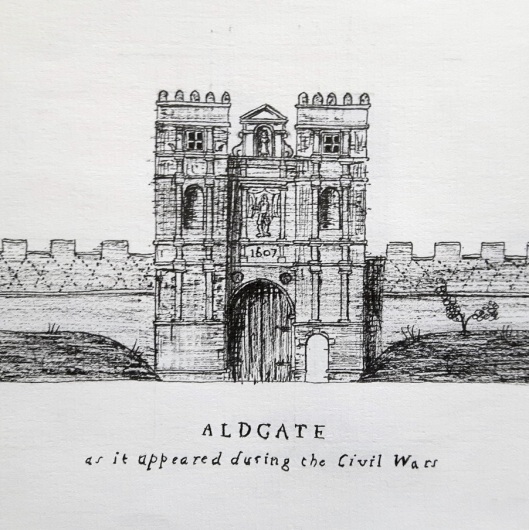Kind reader,
May I happily present this next history of the gates of London – Aldgate.
A L D G A T E
This gate guarded the route to Eastern Britain, including the main route between London and the early Roman capital city of Britain; Colchester. It is supposed to be the earliest gate built in London, a questionable fact since it is likely the earliest defensive gates were built around the Roman fort to the north-west of the city, and it seems more sensible to me that the construction of any of the city gates followed after these. However, Aldgate does appear to be the oldest city gate, and was put up – prior to the city walls – in the mid-2nd century. Its key location led to it becoming the busiest of the Roman entrances into London.
It appears to have been called Eastgate in Saxon times, and then Allgate or Alegate in the early days of Norman England, before finally being settled on as Aldgate as late at the close of the 15th century.
The etymology of this name is obscure, and has numerous suggestions clamouring for acceptance. The first, and most common, is that it is a corruption of Oldgate, being the oldest in the city, but when it gained that name it had been rebuilt enough that it was not the oldest gate in the city, and it is unlikely its true antiquity was common knowledge. It also seems more likely that it is a corruption of the earlier name Allgate or Alegate.
These two earlier names may derive not exclusively from these routes; a gate through which foreigners came, ael being Saxon for foreign; a gate through which ale was brought or near which an alehouse stood; a gate rebuilt by a man named Aethel, Aethelbert, Aethelred, or some other similar Saxon name; or possibly a gate through which all people could pass.
The medieval history of the gate is a little better recorded. It was rebuilt twice, once in the early 12th century and then again a hundred years later in about 1215 following the revolts against King John, this gate the very place that in that latter year the revolting barons entered the city and took command of it. Aldgate was before this rebuilding described as the most ruinous gate in the city.
I can find only two further occasions when the gate was entered by attackers upon the city, once on about the 13th June 1381 during the peasants revolt, when rebels had gained entry across London Bridge and opened Aldgate from the inside to let in their brothers in arms from Essex and beyond. The second time, on the 14th May 1471 (I have also seen this date given as the 11th May), it was less of a defensive failure, and more of a military tactic of the defending commander Robert Basset to open the gate and allow entry to a few of the attackers. These invaders were then closed in and outnumbered. This was during the Wars of the Roses, the unfortunate attackers being Lancastrians under command of Thomas Neville.
It was home in 1374 to Chaucer, whose family had been in the area for many years, he lived there until 1386 while he worked as a customs official. Other notable quarters were within one of the towers just along from the gate, which, rather than being put to military use, had by the end of the 14th century become a hermitage.
The entirety of Chaucer’s gate was pulled down in about 1607. It was rebuilt over the next two years in a more popular Romanesque style, with pedestrian archways that the earlier gate lacked. During the removal of the old gate a hoard of Roman coins was found, of which one Martin Bond picked two to be sculpted either side of the gate entrance. The other decorations on this new gate included statues of two knights, Fortune, Peace, and Charity; and reliefs of the royal coat of arms, and James I.

All of the statues were removed at least by the early 1700s, with the reliefs both removed and the wall behind them knocked through so that windows could be put in. A second pedestrian gate was also added.

This final form stood until 1761, when it was dismantled – briefly being reconstructed at Bethnal Green as a curiosity.
